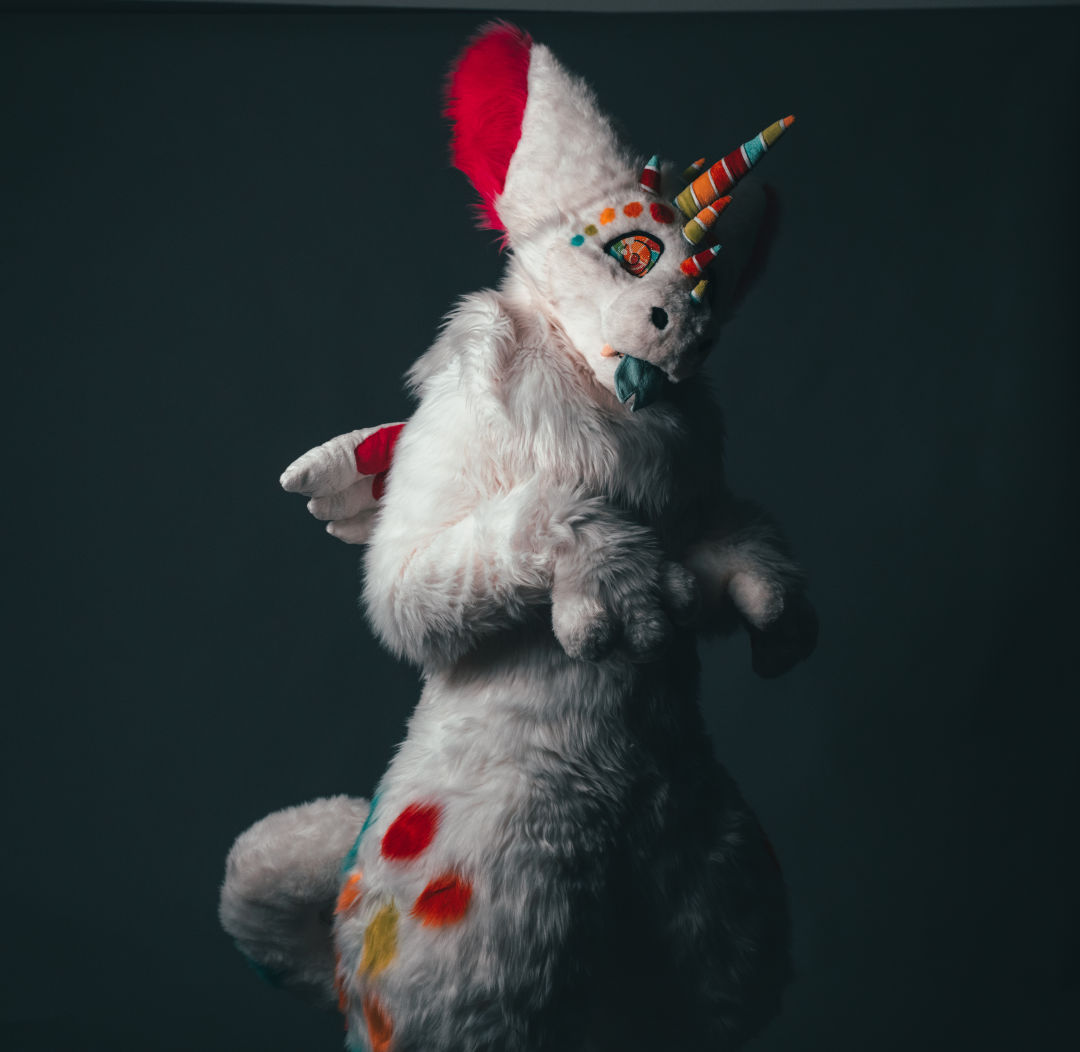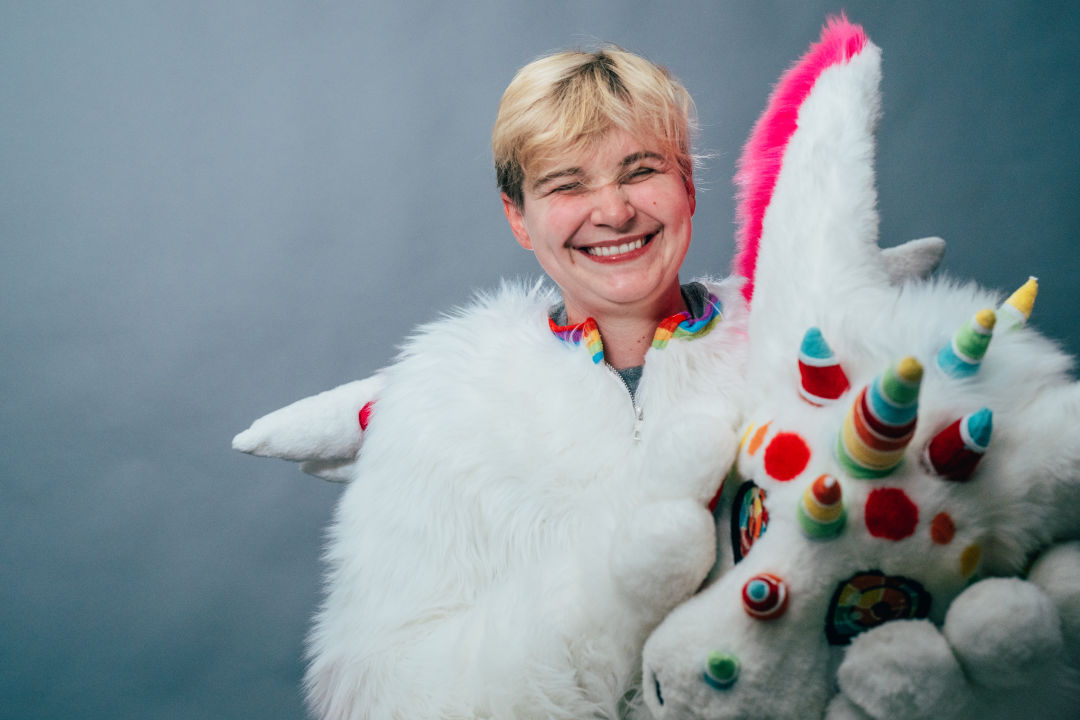How Does a Furry Celebrate Valentine's Day in Sarasota?

AJ Riskey inside her Lolleep suit.
Image: Everett Dennison
If you ever invite a furry to visit your home, make sure your house is free of clutter. The field of vision inside a fursuit is limited, and that's why, when furries are out and about, they are often accompanied by a “handler,” someone who is not in a fursuit who helps and directs the person in the suit.
I learned this when I met Lolleep, who has white fur, feathered wings, a dragon tail, satyr legs, spiral eyes and rainbow-colored horns. Standing in my apartment, I felt like I was in one of those movies that blends live action with animation—like Who Framed Roger Rabbit?
The person in the suit is 30-year-old AJ Riskey, the creator of Lolleep.
“He is a Dutch angel dragon,” Riskey says. “I wanted to base him off of something I hadn’t seen before. I really enjoy lollipops, so I wanted candy aesthetics. Lolleep is a fun, goofy, happy and bright-colored lollipop-themed dragon.”
While Riskey and Lolleep share a love of candy, they have distinct traits. Out of the suit, Riskey is reserved and still. But inside Lolleep she is animated and demonstrative.
“Lolleep is more interactive, bouncy, goofy and confident than I am,” Riskey says. “We are still both nice people, but he’s more expressive and I’m more laid-back.”
Riskey has been a part of the furry community, or what she calls “the fandom,” since 2016. Furries are people who are fans of anthropomorphized animals—usually of the cartoon variety. This way of imbuing animals with human characteristics has been around since the 1970s, but has exploded in popularity over the past decade, largely because of the Internet. Riskey says there are a handful of furries here in the Sarasota area, but they mostly gather at conventions in big cities.
“I knew a little bit about the fandom from other people and the art style," Riskey says. "I went to visit one of my friends in Colorado and she had a fursuit and asked if I wanted to try it. I said, ‘Heck freaking yeah!’ As soon as I put it on and was able to jump around and be goofy, I was like, ‘OK, yeah, I need one of these costumes.’”
Riskey is glad she discovered furries as an adult so she didn’t have to worry about being bullied in school or what her friends and family might think. Chances are, if you’ve heard about furries already, you probably are familiar with dubious stories about how they're corrupting kids by demanding schools provide kitty litter boxes in bathrooms for those who identify as animals. It’s precisely these stigmas that Riskey (and Lolleep) tries to remedy on her TikTok, which has 131,000 followers.

AJ Riskey reveals herself. The temperature insude the suit can reach up to 150 degrees Fahrenheit.
Image: Everett Dennison
“It’s a hobby,” Riskey says. “Not a lifestyle. We don’t believe that we are actually these animals or characters.” Furries choose to put on a suit and they take it off after a couple of hours. Riskey is clear that she doesn't want to be Lolleep. "It’s just a costume,” she says. “If someone can dress up as Superman, we can dress up as characters we made up ourselves.”
According to Riskey, stereotypes about furries being a sexual identity are just that—stereotypes. “There are some furries who have sex in costume, but that just isn’t the majority of the fandom,” she says.
Riskey herself is asexual. “In middle school and high school, I was never interested in being asked out or going on dates,” she says. “That’s what you were supposed to do, and I thought I was really weird for not being interested in that kind of stuff. So I think I always knew.” But it wasn’t until a few years ago that some friends in the LGBTQ community told her that there was a word for her identity.
The new term hasn’t changed Riskey’s life very much. “I wasn’t struggling with it,” she says. “The hardest thing was explaining to people how I felt. Now it’s easier to just tell someone to go Google ‘asexual’ and find out for yourself.”
So how does a furry Dutch angel dragon celebrate Valentine’s Day?
“I’m looking forward to the day after, when all the chocolate goes on sale at 50 percent,” Riskey says. “I don’t need a significant other or relationship to express love. I love my friends, my family, my dog. There’s different kinds of love—not just a romantic one.”
It all seems pretty harmless, no? What’s the difference between furries and the mascots of sports teams? According to Riskey, there’s a lot of overlap with Disney and furries. “Disney is the master of anthropomorphic animals,” she says. “It’s strange that people have bad feelings towards furries when they’ll pay thousands of dollars to go see Mickey Mouse.”
People embodying animals is as old as civilization itself. Egyptians gods were all divine animal heads, while Greek gods would transform into animals to interact with mortals. Vikings would go berserk, eat psychedelic mushrooms and become animals of war. But while the tradition of dressing up like animals remains, this modern anthropomorphism is divorced from spiritual rituals and communion with nature and represents a kind of escape from the modern world. For years now, our traditions have been moving away from communal sacraments and toward individual celebrations and gift giving.
Valentine’s Day itself began as a feast to celebrate Catholic martyrs. Today, it is an interpersonal and commercialized romantic holiday. But Lolleep will not worry about any of these things. He will be busy gorging himself on Valentine's candies with printed messages of love.
“I have responsibilities and bills to pay and Lolleep doesn’t," Riskey says. "He just worries about candy.”



